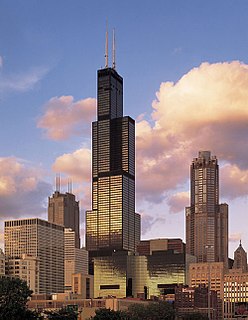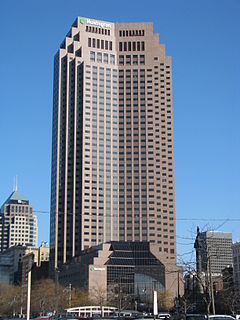
Chicago's architecture is famous throughout the world and one style is referred to as the Chicago School. Much of its early work is also known as Commercial style. In the history of architecture, the first Chicago School was a school of architects active in Chicago at the turn of the 20th century. They were among the first to promote the new technologies of steel-frame construction in commercial buildings, and developed a spatial aesthetic which co-evolved with, and then came to influence, parallel developments in European Modernism. A "Second Chicago School" with a modernist aesthetic emerged in the 1940s through 1970s, which pioneered new building technologies and structural systems, such as the tube-frame structure.

Key Tower is a skyscraper on Public Square in downtown Cleveland, Ohio. Designed by architect César Pelli, it is the tallest building in the state of Ohio, the 34th-tallest in the United States, and the 165th-tallest in the world. The building reaches 57 stories or 947 feet (289 m) to the top of its spire, and it is visible from up to 20 miles (32 km) away. The tower contains about 1.5 million square feet (139,355 m²) of office space.

The buildings and architecture of Chicago have influenced and reflected the history of American architecture. The built environment of Chicago is reflective of the city's history and multicultural heritage, featuring prominent buildings in a variety of styles by many important architects. Since most structures within the downtown area were destroyed by the Great Chicago Fire in 1871 Chicago buildings are noted for their originality rather than their antiquity.

George Browne Post was an American architect trained in the Beaux-Arts tradition. He was recognized as a master of modern American architecture as well as being instrumental in the birth of the skyscraper.
KeyBank, the primary subsidiary of KeyCorp, is a regional bank headquartered in Cleveland and is the only major bank based in Cleveland. KeyBank is 25th on the list of largest banks in the United States.

200 Public Square is a skyscraper in Cleveland, Ohio. The building, located on Public Square in Downtown Cleveland, reaches 45 stories and 658 feet (201 m) with 1.2 million square feet (110,000 m2) of office space. It is the third-tallest building in Cleveland and fourth-tallest in the state of Ohio. The building opened in 1985 as the headquarters for Standard Oil of Ohio or Sohio, and was known as the Sohio Building or Standard Oil building. After British Petroleum (BP) rebranded Sohio as BP in the early 1990s, the building was often called the BP America Building, BP America Tower, BP Tower, or BP Building, and those earlier names are still regularly used even after BP moved its North American headquarters to Chicago in 1998. It was officially renamed 200 Public Square in 2005 and since 2010, has been Cleveland's regional headquarters for Huntington Bancshares.

The AT&T Huron Road Building is an art deco skyscraper located at 750 Huron Road in downtown Cleveland, Ohio. It serves as the corporate headquarters for Ohio Bell, a regional telephone company owned by AT&T. The building has 24 stories and rises to a height of 365 ft. It was designed by the firm of Hubbell and Benes, in what they called "Modern American Perpendicular Gothic", a style influenced by Eliel Saarinen's unrealized design for the Tribune Tower in Chicago. Work on the building began in 1925 and was completed in 1927 at a cost of $5 million. It was briefly the tallest building in Cleveland, surpassed in 1928 by the Terminal Tower.

AmTrust Financial Building, formerly known as McDonald Investment Center, Key Center and the Central National Bank Building, is a commercial high-rise building in Cleveland, Ohio. The building rises 308 feet in Downtown Cleveland. It contains 23 floors, and was completed in 1969. The building currently stands as the 18th-tallest building in the city. When first constructed, the tower stood as the 5th-tallest building in Cleveland. The architect who designed the building was Charles Luckman.

The Standard Building,, is a high-rise office tower located at the southwest corner of Ontario Street and St. Clair Avenue in downtown Cleveland, Ohio. Rising to a height of 282 feet, the Standard Building was the second tallest building in Cleveland when it was completed in 1925. Three of its four sides are clad in cream-colored terra cotta with a recurring starburst motif. The south face, which can be seen from Public Square, is unadorned and windowless. It was designed by Knox and Elliot architects, and was built for $7 million. It was built by the Brotherhood of Locomotive Engineers and Trainmen who owned the building until 2014, when it was sold to Weston, Inc.

Republic Center is a mixed-use complex at 300 N. Ervay Street and 325 N. St. Paul Street in the City Center District of downtown Dallas, Texas (USA), adjacent to Thanks-giving Square. The complex is located diagonally across the street from DART's St. Paul Station, which serves its Blue, Red, Orange, and Green light rail lines. It also contains part of the Dallas Pedestrian Network, with shops and restaurants in the lower levels of the building and is connected to the Bullington Truck Terminal.

The Marriott at Key Center is a skyscraper hotel in Cleveland, Ohio. The building rises 320 feet. It contains 28 floors, and was completed in 1991. The Marriott at Key Center currently stands as the 19th-tallest building in the city. The architect who designed the building was César Pelli, who also designed the neighboring Key Tower, the tallest building in the city and the state. The Marriott at Key Center closely resembles the façade of the Key Tower. These two buildings, together with the Society for Savings Building, comprise Key Center.

The Superior Building, originally known as the Cleveland Discount Building, is a high-rise building in Cleveland, Ohio. The building rises 265 feet in Downtown Cleveland. It contains 22 floors, and was completed in 1922. The Superior Building currently stands as the 28th-tallest building in the city. The architectural firm who designed the building was Walker & Weeks. The building's design incorporates a set of Doric columns in its base.

The AECOM Building, formerly known as the Penton Media Building, and the Bond Court Building, is a commercial high-rise building in Cleveland, Ohio. The building rises 253 feet in Downtown Cleveland. It contains 21 floors, and was completed in 1972. The AECOM Building currently stands as the 29th-tallest building in the city, tied in rank with the Ohio Savings Plaza and Ameritech Center. The architectural firm who designed the building was Skidmore, Owings and Merrill, who also designed Chicago's Willis Tower and Dubai's Burj Khalifa. The building is a part of the Bond Court complex. The Bond Court area used to contain nightclubs and bars but was cleared in the 1960s to 1970s for the office block and the Westin Hotel Cleveland.

The Ohio Savings Plaza is a commercial high-rise building in Cleveland, Ohio. The building rises 253 feet in Downtown Cleveland. It contains 17 floors, and was completed in 1969. The Ohio Savings Plaza currently stands as the 33rd-tallest building in the city, tied in rank with the Penton Media Building and Ameritech Center. The architect who designed the building was George S. Ryder. Ohio Savings Plaza has a tunnel which can be accessed from within a janitor's closet and leads directly to a restroom in the Phoenix Coffee across the street.

Ameritech Center or AT&T Ohio is a commercial high-rise building in Cleveland, Ohio. The building rises 253 feet (77 m) in Downtown Cleveland as a part of the Erieview Plaza complex. It contains 16 floors, and was completed in 1983. AT&T Center currently stands as the 31st-tallest building in the city, tied in rank with the Penton Media Building and the Ohio Savings Plaza. The architectural firm who designed the building was Madison Madison International. AT&T Center contains offices of the Dallas-based AT&T Corporation.

The PNC Bank Building is a 368 ft (112 m) tall skyscraper located at 405 Madison Avenue in Downtown Toledo, Ohio. The limestone-faced steel-frame building was constructed in 1930 and is an example of the Art Deco style of architecture. It stood as Toledo's tallest building for 39 years, from its completion in 1930 until the completion of the Tower on the Maumee in 1969. The PNC Bank Building is currently the third-tallest building in Toledo.























